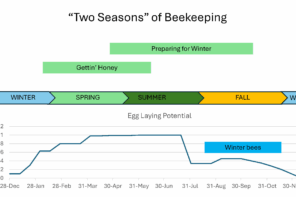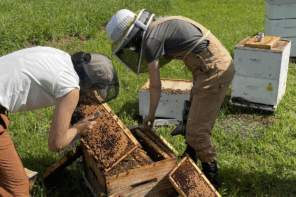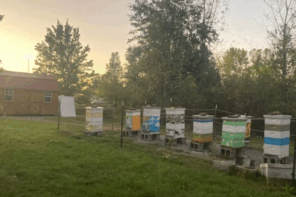Assessing Colonies
Jessica Lawrence
Think about when to watch your colonies decide to die, swarm, or abscond, or explode with growth and maybe you catch them in time. In some cases, beekeepers are very hands-off on their girls, while other beekeepers want to stick their nose in every single day and see what’s happening. The thing that is most important for actually keeping up with your bees (in my opinion) is consistency. If you check your bees every week or every couple weeks, you’ll at least know when they’re about to swarm… maybe. When you perform a hive check, what is it that you are looking for and how does it help you to figure out what your colony needs?
The way I assess colonies is way overboard for most beekeepers, but I have to have the data. In general, this doesn’t have to be quite so insane but hopefully this explanation will help you decide what is most important to you. I would recommend keeping up with your bees in some way via a notebook, or writing all over the hive with a sharpie. After two hives, I no longer have the ability to remember who had what and I definitely won’t remember after a few days. It’s pretty common for me to at least mark the lid with the queen and if she’s marked or not and if she is, what color. Other than that, it’s really up to you what you want to write and where to put it.
On my paperwork, I always keep up with the hive with some kind of identifier, the date and the time. The matrices are how many bees, how much empty space, honey, nectar, pollen, capped brood, open brood and eggs. When each frame is pulled out, both sides of the frame are scanned for an estimate of adult bee coverage because that changes quickly once it’s removed from the hive, and then go back and assess what’s in the cells. For this purpose, the standard dimensions used will be from a plastic frame from Dadant. Since they are mass produced, the cell number doesn’t change and they’re pretty specific dimensions. I would imagine if you really care to do it, you could use my same numbers on a different frame and be pretty close, but if you are to the point of doing this math then you probably went out and counted your own frame cells. Below is a diagram of a plastic frame, with the dimensions and calculations listed.
Now, with this math, it shows what would be the population of adult bees in each hive body as shown by 100% coverage on both sides of each of the 10 frames. This does not include any stragglers on the sides, bees in flight or bees in your veil. A shorter way to do this might be to go through the frames quickly and estimate an average coverage and multiply it. Or, if you only have bees on some frames, only go by those frames instead of using 20 sides. Having an estimate of your in-hive population is a good indicator of colony health because it also lets you see if your brood is successfully emerging into adulthood. You can also do a quick scan for varroa while doing this, but if you can see the mites you probably already have a different problem.
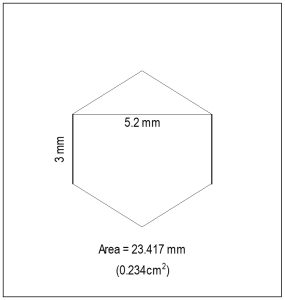
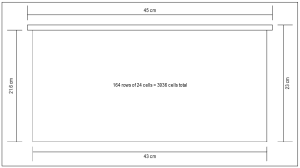
Now, with having 3,936 cells on the frame that are fully formed (some of the corners and edges are not a full hexagon and are excluded from the calculations for consistency), you can go down to how many cells of each bee matrix you have. I don’t know that this is any more reliable than the percent coverage, but sometimes it’s fun to figure out. It might not seem like you have a lot of eggs if you only have something like 5% coverage on a frame, but when you realize that’s almost 200 cells, it definitely can seem like more!
1a40900100000100
| Brood Box Coverage (% of comb) | |||||||||
|---|---|---|---|---|---|---|---|---|---|
| Frame no. | Bees | Empty | Honey | Nectar | Pollen | Capped Brood | Open Brood | Eggs | 100? |
| 1a | 40 | 90 | 0 | 10 | 0 | 0 | 0 | 0 | 100 |
| 1b | 55 | 80 | 0 | 20 | 0 | 0 | 0 | 0 | 100 |
| 2a | 55 | 80 | 0 | 20 | 0 | 0 | 0 | 0 | 100 |
| 3a | 35 | 15 | 5 | 80 | 0 | 0 | 0 | 0 | 100 |
| 4a | 45 | 5 | 15 | 15 | 0 | 65 | 0 | 0 | 100 |
| 5a | 60 | 0 | 5 | 10 | 30 | 45 | 10 | 0 | 100 |
| 5b | 65 | 0 | 5 | 5 | 45 | 35 | 10 | 0 | 100 |
| 6a | 40 | 0 | 0 | 5 | 15 | 75 | 5 | 0 | 100 |
| 6b | 65 | 0 | 5 | 10 | 0 | 70 | 10 | 5 | 100 |
| 7a | 60 | 0 | 0 | 5 | 0 | 30 | 50 | 15 | 100 |
| 7b | 55 | 0 | 0 | 5 | 0 | 35 | 40 | 20 | 100 |
| 8a | 50 | 35 | 5 | 5 | 0 | 55 | 0 | 0 | 100 |
| 8b | 55 | 0 | 0 | 10 | 0 | 35 | 0 | 55 | 100 |
| 9a | 50 | 0 | 0 | 15 | 0 | 25 | 60 | 0 | 100 |
| 9b | 55 | 0 | 10 | 5 | 0 | 35 | 45 | 5 | 100 |
| 10a | 45 | 0 | 25 | 40 | 0 | 10 | 0 | 25 | 100 |
| 10b | 60 | 0 | 25 | 25 | 0 | 25 | 15 | 10 | 100 |
| 1060 | 340 | 155 | 375 | 135 | 615 | 245 | 135 | 100 | |
| Cells | |||||||
|---|---|---|---|---|---|---|---|
| Bee Coverage | Empty | Honey | Nectar | Pollen | Capped Brood | Open Brood | Eggs |
| 14771.1 | 13382 | 6100.8 | 14760 | 5313.6 | 24206 | 9643.2 | 5313.6 |
The visual assessment is the hardest part. I have completed over ten thousand Colony Condition Assessments over the years for various forms of government submissions, and it becomes second nature to spout off numbers in percentages of five. This is easier for me because sometimes there is enough of something that you want to count it but maybe it’s not quite 5%, but you can kind of average it out as you go. You don’t necessarily need to keep up with empty space either. I only use it because I can take the full set and use it to sum each row and make sure it’s 100% on each line. I don’t know if it’s easier for anyone, but when I’ve worked with beekeepers in Germany, they do it in eights instead of 5%. Maybe it’s because the hives are slightly different or it’s easier to them or maybe the Germans are on a different plane of thinking, but I can’t really do those well. If it’s just a general idea, you could do tenths and just make a note if something is present but in small amounts.
If you decide to do these on your own, it normally takes somewhere between 15-30 minutes per hive body, depending on the weather, the size of the colony, and the aggression. Of course, it is the easiest to do on a moderate colony that is extremely chill in sunny weather that makes you sweat to death but not have to wear a veil. It’s a lot harder to see eggs or larvae or anything small really through a veil and if you have a lot of hives to do, this can give you a massive headache. I also like to wear disposable gloves even when I’m not doing it for work because it keeps the honey and sticky off my hands and the bees seem to be less inclined to sting me through the gloves.
| Y/N | |
| Y | Is the queen present? |
| Y | Are swarm cells present? |
| Y | Are supercedure cells present |
| N | Are there signs or symptoms of disease? |
| N | Are there signs or symptoms of Varroa mites? |
| N | Are there any pests presents? |
| N | Are there any unusual behaviors? |
Something to consider during this is time of day. If you look at your bees in the early morning and check them again in two weeks on a sunny afternoon, you might have less adult bees because they are out foraging. If something looks odd or unusual, think about what could have caused it that is not the imminent demise of your colony. A lot of beekeepers jump to crazy conclusions if they are not familiar with pest and disease signs and symptoms, but usually Occam’s razor holds true if you are paying attention.
I have a self-professed “math nerd” Mr. Hirschy, that explained how my acreage calculations were off in one of my earlier articles. A one-mile flight area for a bee is just over 2,000 acres (2,011), and five miles would be 50,265 acres of bee coverage. If he has any opinions on other calculations that might be useful here for assessments, I will share them with everyone if he writes back in. Sometimes it’s easier to get a good idea of your bees if you look at the bigger picture over the year rather than each individual assessment. I’ve included a CCA example from one brood box on a colony in June as an example so you can see how the percentages work out.







